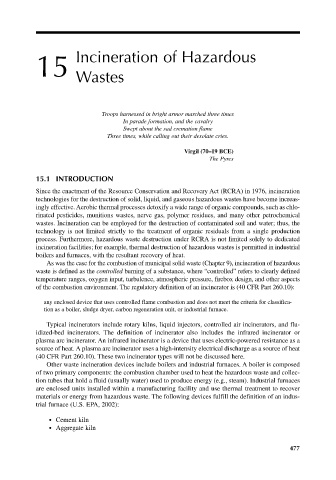Page 506 - Materials Chemistry, Second Edition
P. 506
CAT3525_C15.qxd 1/27/2005 12:40 PM Page 477
15 Incineration of Hazardous
Wastes
Troops harnessed in bright armor marched three times
In parade formation, and the cavalry
Swept about the sad cremation flame
Three times, while calling out their desolate cries.
Virgil (70–19 BCE)
The Pyres
15.1 INTRODUCTION
Since the enactment of the Resource Conservation and Recovery Act (RCRA) in 1976, incineration
technologies for the destruction of solid, liquid, and gaseous hazardous wastes have become increas-
ingly effective. Aerobic thermal processes detoxify a wide range of organic compounds, such as chlo-
rinated pesticides, munitions wastes, nerve gas, polymer residues, and many other petrochemical
wastes. Incineration can be employed for the destruction of contaminated soil and water; thus, the
technology is not limited strictly to the treatment of organic residuals from a single production
process. Furthermore, hazardous waste destruction under RCRA is not limited solely to dedicated
incineration facilities; for example, thermal destruction of hazardous wastes is permitted in industrial
boilers and furnaces, with the resultant recovery of heat.
As was the case for the combustion of municipal solid waste (Chapter 9), incineration of hazardous
waste is defined as the controlled burning of a substance, where “controlled” refers to clearly defined
temperature ranges, oxygen input, turbulence, atmospheric pressure, firebox design, and other aspects
of the combustion environment. The regulatory definition of an incinerator is (40 CFR Part 260.10):
any enclosed device that uses controlled flame combustion and does not meet the criteria for classifica-
tion as a boiler, sludge dryer, carbon regeneration unit, or industrial furnace.
Typical incinerators include rotary kilns, liquid injectors, controlled air incinerators, and flu-
idized-bed incinerators. The definition of incinerator also includes the infrared incinerator or
plasma arc incinerator. An infrared incinerator is a device that uses electric-powered resistance as a
source of heat. A plasma arc incinerator uses a high-intensity electrical discharge as a source of heat
(40 CFR Part 260.10). These two incinerator types will not be discussed here.
Other waste incineration devices include boilers and industrial furnaces. A boiler is composed
of two primary components: the combustion chamber used to heat the hazardous waste and collec-
tion tubes that hold a fluid (usually water) used to produce energy (e.g., steam). Industrial furnaces
are enclosed units installed within a manufacturing facility and use thermal treatment to recover
materials or energy from hazardous waste. The following devices fulfill the definition of an indus-
trial furnace (U.S. EPA, 2002):
● Cement kiln
● Aggregate kiln
477

